the 2007 Abstract Presentations - Wound Healing Society
the 2007 Abstract Presentations - Wound Healing Society
the 2007 Abstract Presentations - Wound Healing Society
You also want an ePaper? Increase the reach of your titles
YUMPU automatically turns print PDFs into web optimized ePapers that Google loves.
<strong>Abstract</strong>s<br />
137<br />
OCCLUSION DECREASES HYPERTROPHIC SCARRING IN A<br />
RABBIT EAR MODEL<br />
K.D. O’Shaughnessy, N.K. Roy, T.A. Mustoe<br />
<strong>Wound</strong> <strong>Healing</strong> Research Laboratory, Division of Plastic Surgery, Department<br />
of Surgery, Northwestern University Feinberg School of Medicine, Chicago, IL<br />
Introduction: Previous studies in our laboratory have shown a reduction in<br />
hypertrophic scarring by silicone gel sheet occlusion. We hypo<strong>the</strong>size that <strong>the</strong><br />
decrease in scar formation is due to hydration sensed by <strong>the</strong> epidermis and<br />
<strong>the</strong>refore occlusion of a wound after epi<strong>the</strong>lization is complete will decrease<br />
scar formation, regardless of which occlusion material is used.<br />
Methods: In an established rabbit model of hypertrophic scarring, 7 mm ear<br />
punch wounds were created in 8 rabbits. The rabbits were divided into four<br />
groups and wounds were occluded with Kelocote, Cavilon, Indermil or tape<br />
stripping on days 14–28. Each rabbit served as its own internal control. All<br />
wounds were harvested on day 28 and examined histologically to measure <strong>the</strong><br />
scar elevation index (SEI), epi<strong>the</strong>lial thickness and cellularity. Ultrastructural<br />
analysis was performed by electron microscopy.<br />
Results: Kelocote, Cavilon and Indermil all significantly decreased SEI when<br />
compared to hypertrophic scar controls. Tape stripping significantly increased<br />
<strong>the</strong> SEI, epi<strong>the</strong>lial thickness and cellularity. Under EM, <strong>the</strong> tape stripped<br />
wounds displayed extensive intercellular edema, intracellular vacuoles, migratory<br />
inflammatory cells and dense collagen. Both unwounded skin and occlusion<br />
treated scars did not display <strong>the</strong>se characteristics.<br />
Conclusions: Hypertrophic scarring was reduced regardless of occlusive method<br />
used. Fur<strong>the</strong>rmore, repeated disruption of <strong>the</strong> permeability barrier by tape<br />
stripping lead to epidermal hyperplasia. This may be due to increased DNA<br />
syn<strong>the</strong>sis within <strong>the</strong> basal cell layer in an attempt to restore homeostasis within<br />
<strong>the</strong> keratinocytes. Intercellular edema of <strong>the</strong> basal cell layer and intracellular<br />
vacuoles seen in unoccluded and tape stripped wounds indicate inflammation<br />
and keratinocyte damage. Occluded wounds may be in an advanced state of<br />
wound repair returning to almost normal states of ultrastructure compared<br />
with untreated or tape stripped skin. Occlusion may mimic <strong>the</strong> intact stratum<br />
corneum and mediate its effects by hydration which is sensed by <strong>the</strong> epidermis.<br />
This study was supported by an NIH grant awarded to T.A. Mustoe<br />
139<br />
CRYOPRESERVED AMNIOTIC MEMBRANE RELEASES<br />
ANGIOGENIC FACTORS<br />
S. Hennerbichler 1,2,3 , B. Reichl 1,2,3 , S. Wolbank 2 , J. Eibl 3 , C. Gabriel 2 , H. Redl 1<br />
1 Ludwig Boltzmann Institute for Experimental and Clinical Traumatology,<br />
Linz-Vienna, Austria,<br />
2 Red Cross Blood Transfusion Service of Upper Austria, Linz, Austria,<br />
3 Bio-Products & Bio-Engineering AG, Vienna, Austria<br />
Preserved amniotic membrane is used in <strong>the</strong> field of ophthalmology and wound<br />
care due to its supporting properties. Typically, amnion is used in a glycerol<br />
preserved or freeze dried state. As we have shown previously, under such<br />
conditions <strong>the</strong> majority of cells are dead, while preserving amnion in fresh or<br />
frozen state under optimised conditions more than 20% of cells can be<br />
preserved. Therefore we investigated which growth factors (GF) and cytokines<br />
are released from cells in viable amnion to <strong>the</strong> culture medium. Fresh and<br />
cryopreserved amnion was incubated for 48 h in protein free medium and <strong>the</strong><br />
medium afterwards screened for GF using a protein array system. Amnion was<br />
also tested for viability and microbiological contamination. The amniotic<br />
membrane was viable and sterile over <strong>the</strong> 48 hour period and <strong>the</strong> medium<br />
contained GF and cytokines. Of <strong>the</strong> 20 protein spots on <strong>the</strong> array, <strong>the</strong> following<br />
gave positive signals – Angiogenin, GRO, IL6/8, MCP-1, TIMP1/2, IGF-1.<br />
Several growth factors and cytokines are released from cryopreserved amniotic<br />
membrane which may be responsible for its supportive properties in tissue<br />
regeneration. This work was partially supported by <strong>the</strong> Lorenz Bohler ¨ Fonds.<br />
138<br />
DERMAL FIBROBLASTS FROM RED DUROC AND<br />
YORKSHIRE PIGS EXHIBIT INTRINSIC DIFFERENCES IN<br />
THE CONTRACTION OF COLLAGEN GELS<br />
I. de Hemptinne, C.L. Gallant-Behm, C.L. Noack, D.A. Hart<br />
University of Calgary<br />
Previous studies have shown that <strong>the</strong> Yorkshire (Y) pig is an ideal model for<br />
skin wound healing, while red Duroc (RD) pigs form hyperpigmented,<br />
hypercontracted scars similar to human hypertrophic scars (1–4). In order to<br />
assess potential intrinsic differences in fibroblast phenotypes, <strong>the</strong> contraction<br />
ability of ventral and dorsal dermal fibroblasts from Y and RD pigs was<br />
determined in vitro. Cells were isolated from juvenile female pigs using<br />
standard methods, propagated, and incorporated into collagen gels. Briefly, a<br />
solution containing bovine collagen was combined with <strong>the</strong> isolated fibroblasts<br />
over a dose range of 5 10 4 –5 10 5 cells/ml. The collagen was neutralized,<br />
distributed into 24 well plates and allowed to solidify at 37 1C. Base media<br />
(containing 2% FBS), or media with 10% FBS, 1 or 10 ng/ml TGFb1 was<br />
added to each well and <strong>the</strong> matrix left for 24 hours before being released. The<br />
gels were photographed at 0, 6, 24, 30 and 48 hours post-release time, and <strong>the</strong><br />
degree of contraction was quantified. The final contraction levels were dependent<br />
on cell density and serum concentration for all cell types. The rates of<br />
contraction of RD dorsal fibroblasts were significantly greater than those for Y<br />
dorsal fibroblasts. The initial contraction rates for ventral fibroblasts were<br />
higher than dorsal fibroblasts for both breeds. Supplementation media with<br />
1–10 ng TGFb1 led to modest alterations in contraction rates, except for Y<br />
ventral cells where contraction was significantly increased. These fibroblastpopulated<br />
collagen matrix contraction studies revealed intrinsically different in<br />
vitro responses with fibroblasts from <strong>the</strong> two breeds of pig. The findings also<br />
indicate that at least some of <strong>the</strong> abnormal skin healing phenotype of RD pigs<br />
may be attributable to <strong>the</strong>se intrinsic differences in cellular behavior between<br />
<strong>the</strong> breeds, and possibly yet to be identified mediators released during healing.<br />
140<br />
ENZYMATIC DEBRIDING AGENTS ARE SAFE IN WOUNDS<br />
WITH HIGH BACTERIAL BIOBURDENS AND STIMULATE<br />
HEALING<br />
R.E. Salas, MD, D. Naidu, MD, F. Ko, BS, M.C. Robson, MD, G. Donate,<br />
DPM, T.E. Wright, MD, W.G. Payne, MD<br />
Institute for Tissue Regeneration, Repair, and Rehabilitation Bay Pines VA<br />
Medical Center Bay Pines, Florida<br />
Historically, proteolytic enzymes were reported to be unsafe in wounds with<br />
significant bacterial bioburden unless used in conjunction with topical antimicrobials.<br />
This study evaluated <strong>the</strong> two most frequently used enzymatic<br />
debriding agents, collagenase and papain-urea in a rodent model of a chronically<br />
infected granulating wound. Fifteen rats underwent a 30% TBSA dorsal<br />
scald burn and were inoculated with 5 10 9 E. coli. On <strong>the</strong> 5th post-burn day,<br />
escharectomies were performed leaving a granulating wound with 4 10 8 bacteria/gm.<br />
of tissue. The wounds were treated with collagenase, papain-urea, or<br />
saline dressings as a control. Every 72 hrs., wounds were traced for planimetry<br />
and biopsied for quantitative bacteriology. Collagenase and papain-urea<br />
statistically decreased <strong>the</strong> bacterial counts in <strong>the</strong> infected wounds compared<br />
with <strong>the</strong> control (P o 0.05). They also accelerated wound closure in this model<br />
compared with <strong>the</strong> control (P o 0.01). In conclusion, <strong>the</strong> common enzymatic<br />
debriding agents appear safe and beneficial even in wounds with high tissue<br />
levels of bacteria.<br />
<strong>Wound</strong> Rep Reg (<strong>2007</strong>) 15 A14–A54 c <strong>2007</strong> by <strong>the</strong> <strong>Wound</strong> <strong>Healing</strong> <strong>Society</strong><br />
A51




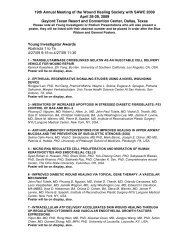

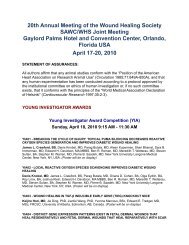
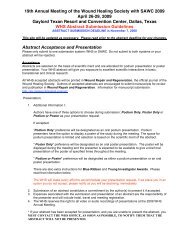
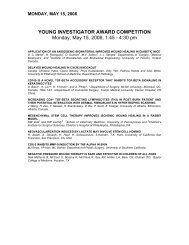



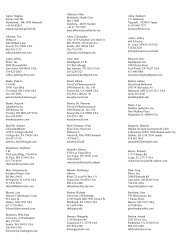
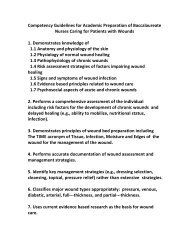
![2010 Abstracts-pah[2] - Wound Healing Society](https://img.yumpu.com/3748463/1/190x245/2010-abstracts-pah2-wound-healing-society.jpg?quality=85)